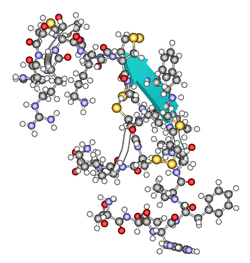Hepcidin
| Hepcidin-25 | ||
|---|---|---|

|
||
| Ribbon / ball model according to PDB 1M4F | ||
| Properties of human protein | ||
| Mass / length primary structure | 25 amino acids | |
| Precursor | Prohepcidin (60 AA) | |
| Identifier | ||
| Gene name | HAMP | |
| External IDs | ||
| Occurrence | ||
| Homology family | Hepcidin | |
| Parent taxon | Eutheria | |
Hepcidin-25 ( hep atical bacteri cid al prote in , Hepcidin for short, also LEAP1, l iver expressed antimicrobial peptide 1) is the name of a protein with 25 amino acids in higher mammals . Hepcidin-25 plays an important role in the regulation of iron metabolism by slowing down the absorption of iron via the intestine and placenta and the release of iron from the reticuloendothelial system (RES). Hepcidin-25 was initially described as a peptide which is involved in the defense against microbes . A deficient hepcidin effect is involved in the autosomal recessive forms of hemochromatosis (types 1 - 3).
education
The body produces hepcidin from a precursor, a prepropeptide with 84 amino acids, in the liver. Pro-Hepcidin is the HAMP - gene (HFE-2B) coded. It is produced more when iron and oxygen (with a good iron supply and good oxygen transport into the tissues) and interleukin -6 (with inflammation) are more available.
Effects
Hepcidin-25 binds e.g. B. in small intestinal mucosa cells and in macrophages to ferroportin , which normally transports iron out of the cell interior. If hepcidin is bound to ferroportin, these cells can no longer export iron and release it in the blood to the transport protein transferrin . Small intestinal mucosal cells can only export their absorbed iron via ferroportin in the last two days before they are rejected into the intestine; If a lot of ferroportin is inactivated by hepcidin, the iron absorbed into these cells is lost again through the stool with the exfoliation of the cells. Hepcidin regulates iron absorption in the intestine. Hepcidin also plays an important role in altering iron metabolism in chronic inflammation . The increased interleukin-6 in such inflammations leads to an increase in the hepcidin level. This then holds the iron in the macrophages, which break down old erythrocytes in the spleen, and prevents prompt recycling, which then leads to inflammation-related anemia .
Mammals cannot actively excrete iron. The iron balance is thus essentially regulated by the iron uptake by the hepcidin.
A hepcidin agonist can be used by inhibiting ferroportin-controlled iron transport from the intestinal cells in the case of iron overload, such as in hemochromatosis or in the context of secondary increased iron levels in the body, for example in congenital anemia such as thalassemia or sideroblastic anemia . A first hepcidin agonist in the form of a synthetic protein, which is similar to the first nine amino acids of hepcidin, but has been modified to such an extent that it can be taken orally, has proven itself as "minihepcidin" in initial experiments, effectively reducing the blood iron concentration and preventing it iron storage in the liver. A hepcidin antagonist for the treatment of anemia associated with chronic diseases and the rare iron-resistant iron deficiency anemia, which is based on increased hepcidin formation, is also being developed.
Laboratory values
Hepcidin and its precursor, namely pro-hepcidin, can be detected in blood and urine .
See also
Individual evidence
- ↑ UniProt P81172
- ↑ Ganz T, Nemeth E: Iron imports. IV. Hepcidin and regulation of body iron metabolism . In: Am. J. Physiol. Gastrointest. Liver Physiol. . 290, No. 2, February 2006, pp. G199-203. doi : 10.1152 / ajpgi.00412.2005 . PMID 16407589 .
- ↑ Vaulont S, Lou DQ, Viatte L, Kahn A: Of mice and men: the iron age . In: J. Clin. Invest. . 115, No. 8, August 2005, pp. 2079-82. doi : 10.1172 / JCI25642 . PMID 16075054 . PMC 1180554 (free full text).
- ^ Nancy C. Andrews: Closing the Iron Gate . In: New England Journal of Medicine . tape 366 , no. 4 , 2012, p. 376-377 , doi : 10.1056 / NEJMcibr1112780 , PMID 22276828 .